Looking for ideas for an unforgettable trip to The Land of the Atlas?
We’ve got you covered with some of the best things to do in Marrakech, Morocco. Whether you want to behold ancient architecture, a local’s guide to the bustling markets, or capture incredible photos during a sunset camel ride in the desert, we have just that.
For visitors planning a trip to Morocco, we bring some great ideas on things to do and try in Marrakech, along with expert tips and essential advice.
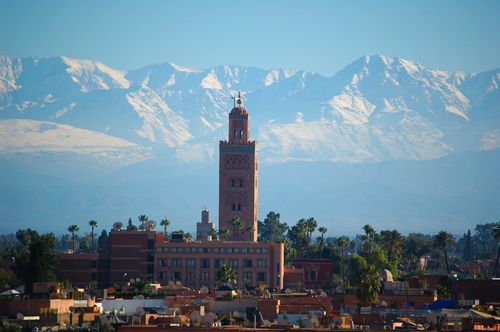
Photo by Paul Macallan on Unsplash
What Is Marrakech Most Famous For?
Marrakech is one of Morocco’s most fabled cities. Founded in 1070 by the Almoravid dynasty, it is renowned for its Islamic architecture, culture, and history.
With its Berber rulers coming from the nearby Atlas Mountains, Marrakech became their capital. It is also known as the “Red City” due to its reddish-pink clay buildings and walls around it. Visit Marrakech to experience traditional, vibrant souks alongside modern tourist attractions in a sight that is hard to resist.
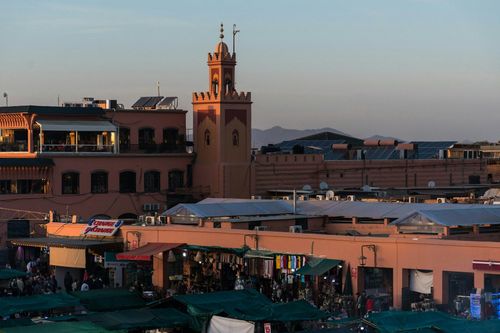
Photo by Desert Morocco Adventure on Unsplash
What to Do in Marrakech in Morocco? 10 Of The Best Things To Do
Visit Jemaa el-Fna Square
Jemaa el-Fna Square is located at the center of Marrakech Medina, lined with souks, cafes, or monuments like Koutoubia Mosque. The square has long served as a meeting place and once as an area for public events. Its name, meaning “assembly of the dead,” evokes its former use. In 2001, UNESCO declared it a Masterpiece of Oral Heritage.
Visitors should know that this square is alive during the day, and at sunset, it gets even busier. Jemaa el-Fna Square is easily reachable on foot from Medina or by hired taxi. The square can be packed with musicians, snake charmers, and acrobats, too.
At night, the food shops make Tagines and grilled meats, while the nearby souks offer a variety of spices and souvenirs.
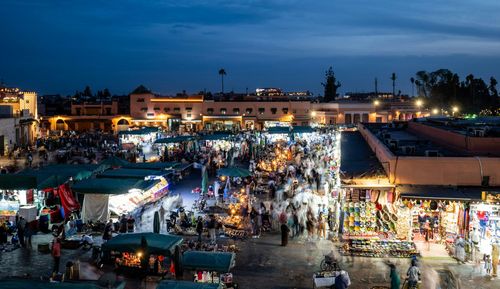
Photo by Tommy Cornilleau on Unsplash
Explore the Souks of Marrakech Medina
Close to Jemaa el-Fna Square lies the souks of Marrakech Medina. They stretch through narrow alleys with each section offering a different type of goods.
What are the souks in Marrakech, you may ask? They are traditional markets that sell handmade goods, spices, textiles, metalwork, leather goods, jewelry, and more. These markets showcase traditional crafts passed down through generations. The souks have long been key to Marrakech’s economy and culture, with some even tracing their origins to ancient trade routes.
It’s best to visit early in the morning if you want to avoid crowds, as late afternoons tend to be much busier. Don’t be shy to haggle, it’s a common practice, and many vendors are used to it.
Walking is the only way to get around the souks of Marrakech Medina. If you’re coming from outside, take a taxi to Jemaa el-Fna and walk from there. Keep an eye on landmarks to avoid losing your way
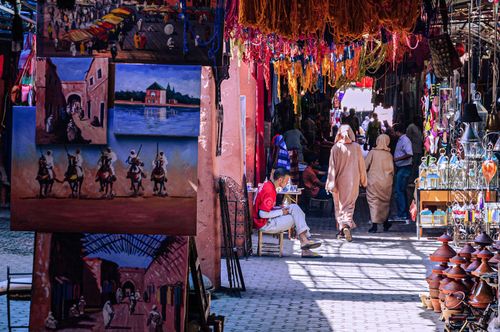
Photo by Esteban Palacios Blanco on Unsplash
Tour the Koutoubia Mosque in Marrakech
The Koutoubia Mosque is at the southwestern corner of Medina, south of Jemaa el-Fna Square.
You’ll find it easily thanks to its tall minaret. The 12th-century Islamic house of worship took on its name from the merchant book market that once surrounded it. The Koutoubia Mosque is the largest mosque in Marrakech and remains an active place of worship even today.
The grounds and gardens are open free of charge but note that non-Muslims are not allowed to go into the mosque. The best times to go are early morning and late afternoon, not just because of its cooler temperatures but also for great photo opportunities.
This 77-meter minaret looks very impressive at sunset or lit up at night. Dress appropriately, and if you time your visit during the call to prayer, take a moment to truly listen. It’s a memorable thing to do in Marrakech, Morocco.
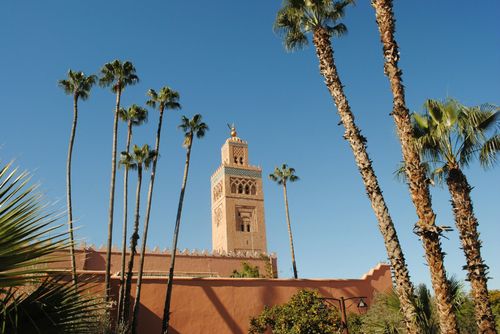
Photo by JR Harris on Unsplash
Walk Through Marrakech’s Jardin Majorelle
Situated in the Gueliz district, just outside Medina, the gardens were designed by French artist Jacques Majorelle in the 1920s and 30s.
After being restored by Yves Saint Laurent himself, the famous fashion designer, and Pierre Bergé in the 1980s, they became one of Morocco’s top attractions. Its striking blue color, lush plant collection, along unique architecture, make it an unmissable thing to do in Marrakech, Morocco, for anyone visiting the country.
You can reach Marrakech’s Jardin Majorelle easily either by taxi or on foot, depending on which nearby hotel you are staying in. The entrance fee is 120 MAD (~ $12), plus an extra fee for the Berber Museum. More than 300 plant species are set among the amazingly bright blue buildings and fountains. You will be able to see a Memorial to Yves Saint Laurent and a small gift shop. The garden is wheelchair-friendly, with numerous benches to sit down and rest if needed.
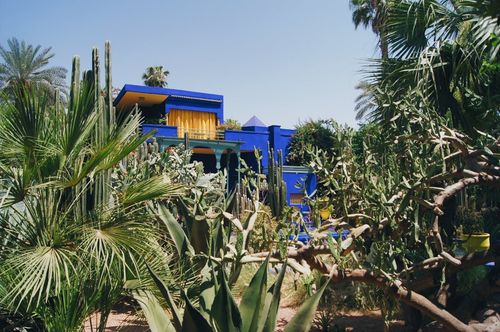
Photo by Nicole Ashley Rahayu Densmoor
Discover Bahia Palace in Marrakech
The Bahia Palace is one of Marrakech’s most visited historical sites. It is located in southern Medina, not very far from the Mellah and El Badi Palace. It was built in the late 19th century by the grand vizier Si Moussa and was enlarged later by his son.
While Bahia means brilliance, it isn’t a royal palace. It was really designed to reflect the wealth and grandeur of the Moussa family. The palace is a remarkable blend of Moroccan Islamic style and represents the architectural trends of the era.
The palace opens at 9:00 AM, and early visits are best to avoid the crowds. While exploring nearby neighborhoods and the outside views of the palace are free, the entrance fee is 70 MAD (~ $7).
The Bahia Palace features carved tilework in much detail, carved stucco, stained glass in color, and cedarwood ceilings. A grand marble courtyard and small gardens complete with fountains. Orange trees offer a calm contrast to its interior decoration.
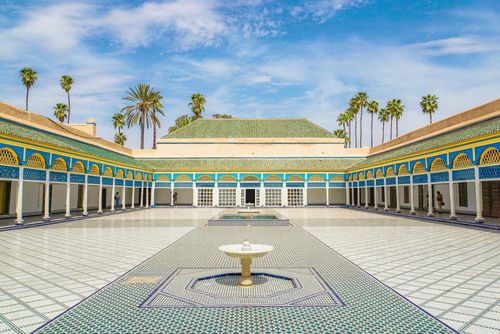
Explore El Badi Palace Ruins
If you plan to visit Bahia Palace, then you should also visit El Badi Palace, which is next to it, in southern Medina, and the Mellah.
It was built toward the end of the 1500s by Sultan Ahmed al-Mansur using Italian marble and Sudanese gold to evoke power. In the 1600s, Sultan Moulay Ismail plundered it to use its materials for his city, Meknes.
What was once a magnificent 16th-century palace in Marrakech now stands as a reminder of Morocco’s royal history, with many things to do and see, despite being largely in ruins.
From Jemaa el-Fna Square, walking to El Badi Palace will take about 10 to 15 minutes. The palace is open from 9:00 AM to 5:00 PM. You can go either in the morning or afternoon for cooler weather and good light.
Entrance tickets start at an affordable 100 MAD (~$10 USD). The large courtyard, with ornate pools, sunken gardens, and stork nests is among the palace’s attractions. The views of Marrakech and the Atlas Mountains can be enjoyed from the terrace.
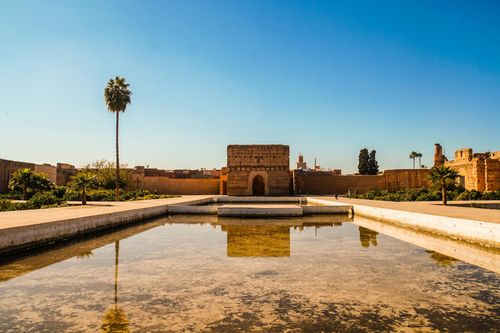
Take a Camel Ride in the Marrakech Desert
For centuries, camel rides have been part of the culture of North Africa, used as a means of trade and travel across the vast Sahara desert.
In Marrakech, you can take a camel ride in two main locations: the Agafay Desert or the Palmeraie. The Agafay Desert, about 30-45 minutes from the city, has a more rocky, desert landscape. The Palmeraie, much closer to town, is a greener palm grove. You can easily get to both by taxi.
A typical ride lasts about an hour, while the cost is within the range of 200-400 MAD ($20-$40). In certain tours, tea is offered in Berber tents. Sunset camel rides are a very popular thing to do in Marrakech, Morocco, as they allow tourists to take outstanding photos in the golden light of the desert.
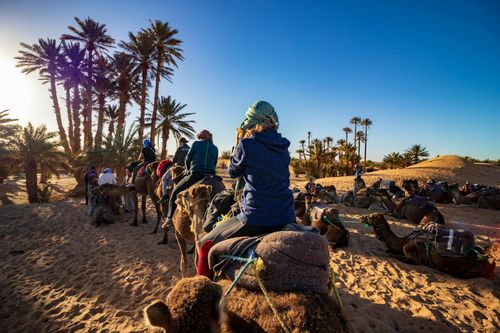
Photo by Tomáš Malík on Unsplash
Visit the Saadian Tombs in Marrakech
Saadian Tombs are located in the Kasbah district of Marrakech, next to the Kasbah Mosque and the ruins of El Badi Palace. They date back to the 16th century, built during the rule of Sultan Ahmed al-Mansur.
The main part of the complex is the Hall of Twelve Columns, which is the final resting place of the Saadian dynasty. The tombs are known for impressive tile work, ornate stucco carvings, and cedar wood detailing. The site also includes tiny gardens with palm trees, like a peaceful oasis amidst the busy city of Marrakech.
For many years, the tombs were sealed off by a later ruler, Sultan Moulay Ismail, who sought to erase the legacy of the Saadian dynasty. They were luckily rediscovered in 1917.
A visit to the Saadian Tombs can be very quick, in under an hour if you’d like. Entry is around 70 MAD or $7 US. The paths are narrow but largely accessible.
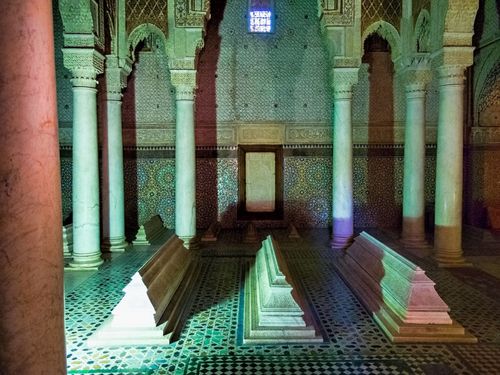
Photo by Dan Lundberg is licensed under CC BY-SA 2.0
Hike the Atlas Mountains from Marrakech
The Atlas Mountains are located about 1.5 to 2 hours south of Marrakech. Most treks start from Imlil, a village near Mount Toubkal, the highest peak in North Africa, where a number of Berbers have traditionally lived.
Mount Toubkal needs a two-day trek though, with overnight stays in mountain huts or camps. Most treks will pass through some Berber villages such as Imlil and Aroumd either on the way up or down. It’s a great opportunity to get acquainted with local life and culture.
The region is a popular destination known for hiking, trekking, and exploring the natural beauty of Marrakech, Morocco, with many things to do for adventure enthusiasts and nature lovers alike.
Landscapes shift with altitude: from snow-capped summits down to valleys. Ourika Valley offers shorter hikes through gorges, waterfalls, and villages, with the option to use mules for transportation if needed.
The terrain can be challenging, so it’s advisable to hire a local guide for safety. There is no entrance fee, but guided walks start from 400 to 800 MAD ($40 to $80). It’s important to bring proper footwear, water, and sun protection, as the weather can vary and the hike can be strenuous in some areas.
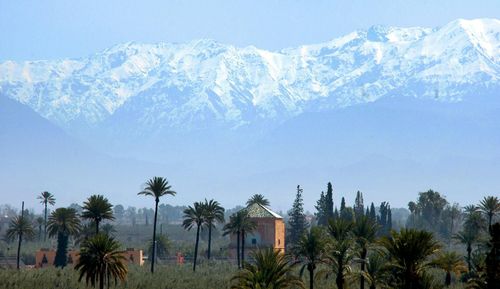
Expert Tips for Visitors in Marrakech
-
Don’t be shy to haggle: Haggling is part of the culture in Marrakech’s markets; start low with a bit of humor. Sellers are used to it, and it can add some fun to shopping if done politely.
-
Ride petit taxis with caution: Always ask locals, like your hotel staff, what the average fare should be. If the driver insists on using a meter, stand firm and ask for it to be turned on; otherwise, negotiate the fare before hopping in to avoid surprises.
-
Explore early or late: Sightseeing popular hot spots, like Jemaa el-Fna square, very early in the morning or just before sunset, when the temperature is much more pleasant and fewer people are around.
-
Use “inshallah” to politely decline: If a vendor insists that you visit his shop, a simple “Inshallah” (God willing), accompanied by a smile, usually does the trick.
-
Stay alert at Jemaa el-fna: The crowded square is filled with jugglers and street performers, including many food stalls all vying for your attention. Politely decline henna artists and food stall vendors if you’re not interested in their wares.
Stay Connected in Morocco with Yoho Mobile
Planning to visit Marrakech? How will you keep track of local events or stay in touch with family?
With mobile data, you’re always connected and informed. Yoho Mobile eSIM offers you reliable internet access no matter where your journey takes you. It’s the easiest and fastest solution—perfect for travelers who want to stay online while enjoying the festivities.
🎁 Exclusive Offer for Our Readers!🎁Enjoy a 12% discount on your orders with Yoho Mobile. Use the code 🏷 YOHOREADERSAVE 🏷 at checkout. Stay connected and save more on your trips with our eSIM. Don’t miss out—start saving today! |
